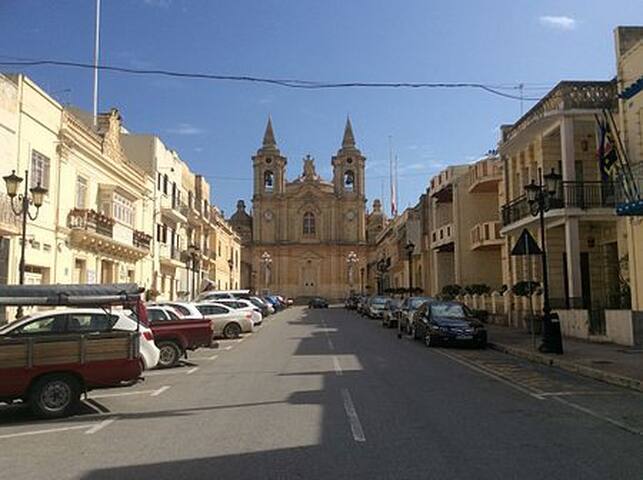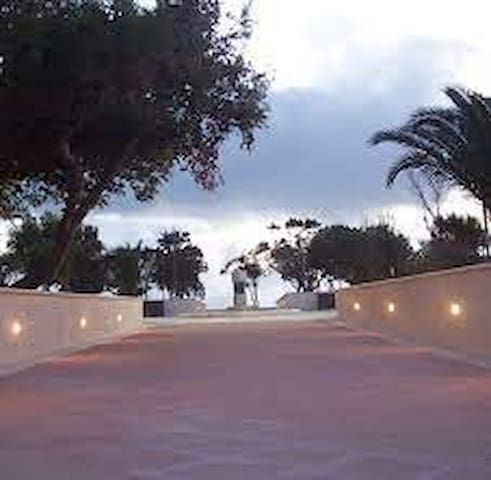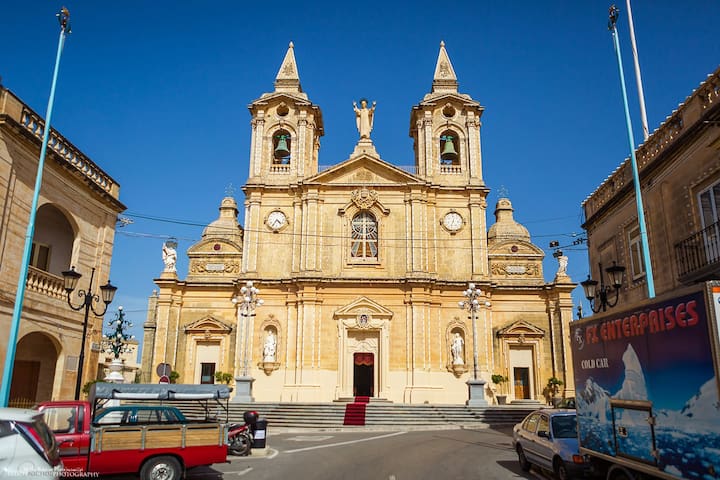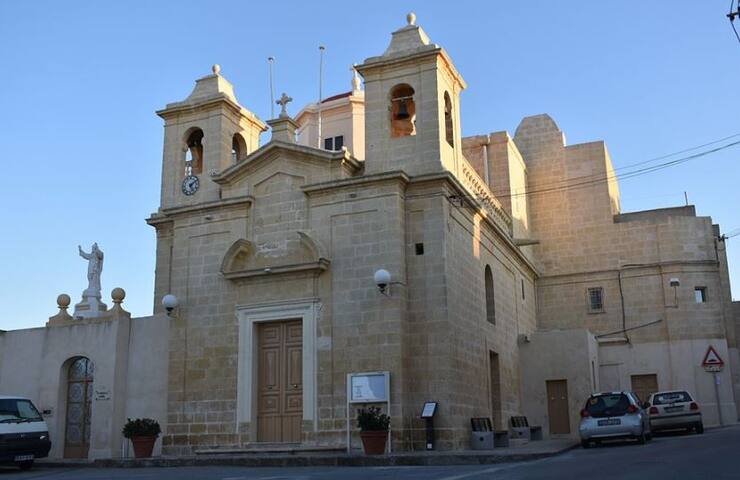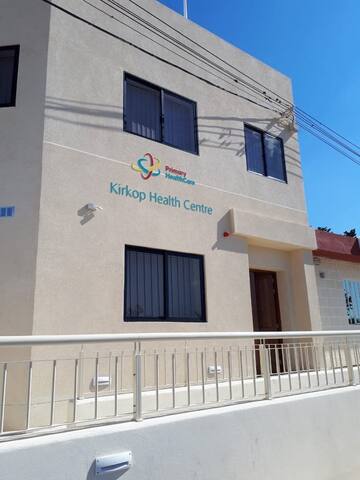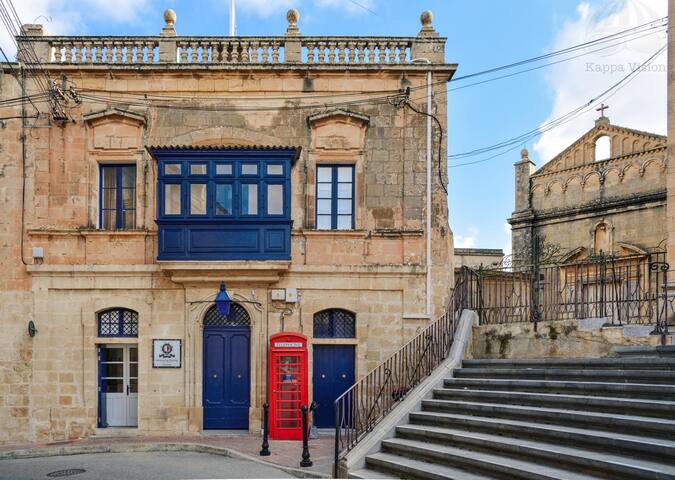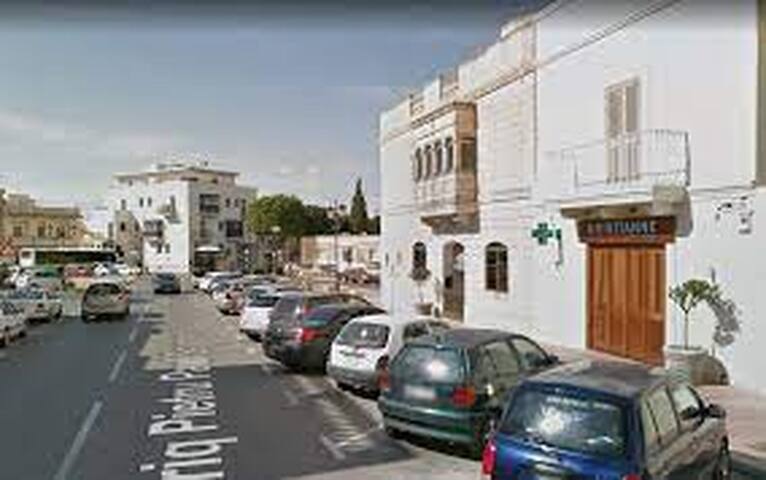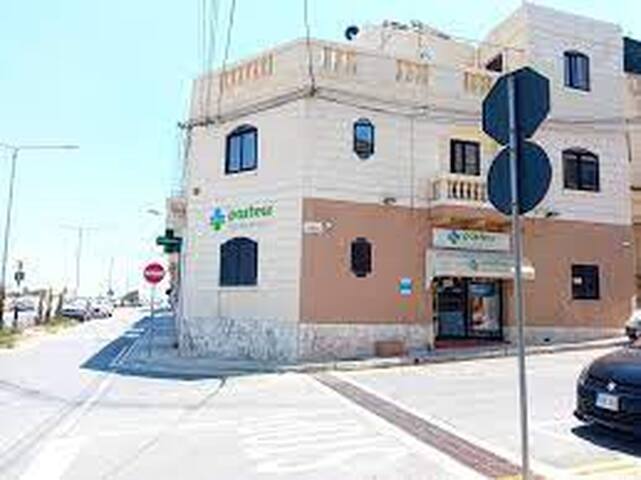Sightseeing
Blue Grotto is a complex of sea caves along the south eastern part of Malta, right across from the little islet of Filfla.
On sunny days, the reflection of sunlight on the white sandy seafloor lights up the caves in bright blue hues, which is a true spectacle to admire!
Tourists can enjoy the amazing grotto via local boat trips. It is also a very popular diving, snorkeling and swimming spot, with very clear, clean and deep waters.
123 lokal ang nagrerekomenda
Asul na Grotto
Blue Grotto is a complex of sea caves along the south eastern part of Malta, right across from the little islet of Filfla.
On sunny days, the reflection of sunlight on the white sandy seafloor lights up the caves in bright blue hues, which is a true spectacle to admire!
Tourists can enjoy the amazing grotto via local boat trips. It is also a very popular diving, snorkeling and swimming spot, with very clear, clean and deep waters.
A little cove with an abundance of restaurants, cafe/bar, a historic watch tower, a public garden, car park, stunning diving spots and boat rides to the marvelous Blue Grotto. The area also enjoys fantastic views of the islet of Filfla.
33 lokal ang nagrerekomenda
Wied Iż-Żurrieq
A little cove with an abundance of restaurants, cafe/bar, a historic watch tower, a public garden, car park, stunning diving spots and boat rides to the marvelous Blue Grotto. The area also enjoys fantastic views of the islet of Filfla.
One of the lushest valleys in Malta lies on the outskirts of Zurrieq, between the village itself and the Blue Grotto. Its landscape changes with the seasons, while the steep rocky sides inspire awe in anyone (especially those who love to climb them) and you might even take a dip in the sea once you’ve walked along Babu valley to its mouth.
9 lokal ang nagrerekomenda
Wied Babu
Triq WiedOne of the lushest valleys in Malta lies on the outskirts of Zurrieq, between the village itself and the Blue Grotto. Its landscape changes with the seasons, while the steep rocky sides inspire awe in anyone (especially those who love to climb them) and you might even take a dip in the sea once you’ve walked along Babu valley to its mouth.
Within walking distance from Wied iz-Zurrieq, one can find an amazing megalithic temple site that date to circa 3,600-3,200 BC.
Ħaġar Qim is a UNESCO World Heritage Site and is older than the Egyptian Pyramids and Stonehenge.
The main Ħaġar Qim structure consists of 5 rooms or apses with a corridor down the middle. A bird’s eye view would show the clear resemblance to a woman’s body, including hips, chest and head. This layout and other artefacts found on site, such as small clay figurines, suggest that the structures were most probably shrines erected to worship mother earth and the fertility cycles. A 5.2-metre high monolith on the outside of the temple could resemble the male. During sunrise on Summer Solstice, the rays of a sun penetrate the temple through a hole to illuminate a particular stone slab–yet another reference to the fertility theory.
165 lokal ang nagrerekomenda
Ħaġar Qim
Triq Hagar QimWithin walking distance from Wied iz-Zurrieq, one can find an amazing megalithic temple site that date to circa 3,600-3,200 BC.
Ħaġar Qim is a UNESCO World Heritage Site and is older than the Egyptian Pyramids and Stonehenge.
The main Ħaġar Qim structure consists of 5 rooms or apses with a corridor down the middle. A bird’s eye view would show the clear resemblance to a woman’s body, including hips, chest and head. This layout and other artefacts found on site, such as small clay figurines, suggest that the structures were most probably shrines erected to worship mother earth and the fertility cycles. A 5.2-metre high monolith on the outside of the temple could resemble the male. During sunrise on Summer Solstice, the rays of a sun penetrate the temple through a hole to illuminate a particular stone slab–yet another reference to the fertility theory.
Within walking distance from Wied iz-Zurrieq, one can find an amazing megalithic temple site that date to circa 3,600-3,200 BC.
Mnajdra Temples are a UNESCO World Heritage Site and is older than the Egyptian Pyramids and Stonehenge.
The temple complex consists of three structures from different prehistoric periods, with the oldest one possibly having over 5500 years. These are known as the East Temple (the oldest), the South Temple and the Central Temple. From other remains around the area, archaeologists believe that the site could have also contained other dwellings.
The South Temple at Mnajdra is the most famous of the three. It is aligned with the four seasons, and if you visit the temple at sunrise on the first day of each season you’ll have a remarkable experience. As the sun rises above the Ħaġar Qim hill, a ray of sun enters the main door and hits one of two large slabs on the inside of the temple, depending on the season. Both slabs are decorated with hundreds of tiny holes.
66 lokal ang nagrerekomenda
Mnajdra
Within walking distance from Wied iz-Zurrieq, one can find an amazing megalithic temple site that date to circa 3,600-3,200 BC.
Mnajdra Temples are a UNESCO World Heritage Site and is older than the Egyptian Pyramids and Stonehenge.
The temple complex consists of three structures from different prehistoric periods, with the oldest one possibly having over 5500 years. These are known as the East Temple (the oldest), the South Temple and the Central Temple. From other remains around the area, archaeologists believe that the site could have also contained other dwellings.
The South Temple at Mnajdra is the most famous of the three. It is aligned with the four seasons, and if you visit the temple at sunrise on the first day of each season you’ll have a remarkable experience. As the sun rises above the Ħaġar Qim hill, a ray of sun enters the main door and hits one of two large slabs on the inside of the temple, depending on the season. Both slabs are decorated with hundreds of tiny holes.
Ghar Lapsi is a secluded beach, which is very popular amongst swimmers and divers.
Ghar Lapsi beach is a unique and hidden little bay with a view over Filfla, situated around 1 km away from the popular Blue Grotto. Ghar Lapsi and its rocky shoreline form a natural swimming pool with crystal clear and fantastic azure blue/green waters perfect for snorkeling.
Ghar Lapsi Cave leads out into the deep open sea and is an excellent dive with fantastic visibility that allows for great underwater photography. Since Ghar Lapsi is very beautiful and a naturally protected area, it is very popular for swimming and diving into the deep waters from the surrounding rocks. There is no extended space for sun bathing, apart from a few small areas of flat rock.
Ghar Lapsi’s surrounding terrain and coastline are ideal for breathtaking countryside hikes and offer excellent spots for rock climbing.
37 lokal ang nagrerekomenda
Ghar Lapsi
Ghar Lapsi is a secluded beach, which is very popular amongst swimmers and divers.
Ghar Lapsi beach is a unique and hidden little bay with a view over Filfla, situated around 1 km away from the popular Blue Grotto. Ghar Lapsi and its rocky shoreline form a natural swimming pool with crystal clear and fantastic azure blue/green waters perfect for snorkeling.
Ghar Lapsi Cave leads out into the deep open sea and is an excellent dive with fantastic visibility that allows for great underwater photography. Since Ghar Lapsi is very beautiful and a naturally protected area, it is very popular for swimming and diving into the deep waters from the surrounding rocks. There is no extended space for sun bathing, apart from a few small areas of flat rock.
Ghar Lapsi’s surrounding terrain and coastline are ideal for breathtaking countryside hikes and offer excellent spots for rock climbing.
Windmill known as tax-Xarolla, was built by Grandmaster Manoel de Vilhena, in 1724. In 1992, this was restored to its original working order is now the only functioning windmill in the islands of Malta and Gozo. This is a valuable witness of local culture and heritage still has parts of the original mechanisms and can still grain the wheat. In the year 2000, this building was passed over to be administered by the Zurrieq Local Council and is intended to serve also as a cultural centre.
Mitħna tax-Xarolla
Triq Sant'AndrijaWindmill known as tax-Xarolla, was built by Grandmaster Manoel de Vilhena, in 1724. In 1992, this was restored to its original working order is now the only functioning windmill in the islands of Malta and Gozo. This is a valuable witness of local culture and heritage still has parts of the original mechanisms and can still grain the wheat. In the year 2000, this building was passed over to be administered by the Zurrieq Local Council and is intended to serve also as a cultural centre.
City/Town Information
Zurrieq is located in the South West of Malta and seems to be one of the oldest towns in Malta. In fact, a collection of remains dates back to the Bronze, Punic and Roman times was found. Such heritage includes tombs, pottery, the Punic Tower, Xarolla Catacombs, Cart Ruts at 'Tal-Bakkari' and 'Tal-Hlantun Tower' amongst others. The first documentation shows that back in 1436 it already had a parish church dedicated to St. Catherine of Alexandria, while other heritage from the times of the Knights and the British still remain. Structures from the 15th and 16th century are spread across the town, such as the Xarolla Windmill, Armoury, Palazzo Ganbatist, the Wardija Tower and Bubaqra Tower. Żurrieq is also famous for the beach in Wied iż-Żurrieq and the Blue Grotto.
Zurrieq will give you an insight of a typical Maltese village life.
Two great annual feasts are celebrated, one at the end of July and the other at the end of September. Traditional nougat and other sweet delicacies, fast food and other stands are next to each other to sell their wares to the crowd. The evenings often end with spectacular ground and aerial fireworks displays in an explosion of colour, firecrackers and loud petards.
10 lokal ang nagrerekomenda
Zurrieq
Zurrieq is located in the South West of Malta and seems to be one of the oldest towns in Malta. In fact, a collection of remains dates back to the Bronze, Punic and Roman times was found. Such heritage includes tombs, pottery, the Punic Tower, Xarolla Catacombs, Cart Ruts at 'Tal-Bakkari' and 'Tal-Hlantun Tower' amongst others. The first documentation shows that back in 1436 it already had a parish church dedicated to St. Catherine of Alexandria, while other heritage from the times of the Knights and the British still remain. Structures from the 15th and 16th century are spread across the town, such as the Xarolla Windmill, Armoury, Palazzo Ganbatist, the Wardija Tower and Bubaqra Tower. Żurrieq is also famous for the beach in Wied iż-Żurrieq and the Blue Grotto.
Zurrieq will give you an insight of a typical Maltese village life.
Two great annual feasts are celebrated, one at the end of July and the other at the end of September. Traditional nougat and other sweet delicacies, fast food and other stands are next to each other to sell their wares to the crowd. The evenings often end with spectacular ground and aerial fireworks displays in an explosion of colour, firecrackers and loud petards.
Park and Gardens
"Gnien il-Gibjun" offers an excellent recreational area for children and adults alike. The garden boasts views of "Wied Babu", the magnificent Mediterranean sea beyond, and the miniscule island of "Filfla".
At the entrance to the gardens, one can find the Zurrieq Bocci Club, where club members play this old traditional Maltese game.
A café/bar is situated inside the garden.
The gardens are situated on the left of the apartment. Then, turn left onto Triq il-Mithna tal-Qaret and the entrance is on the right.
Ġnien Il-Ġibjun
Triq Il-Mitħna Tal-Qaret"Gnien il-Gibjun" offers an excellent recreational area for children and adults alike. The garden boasts views of "Wied Babu", the magnificent Mediterranean sea beyond, and the miniscule island of "Filfla".
At the entrance to the gardens, one can find the Zurrieq Bocci Club, where club members play this old traditional Maltese game.
A café/bar is situated inside the garden.
The gardens are situated on the left of the apartment. Then, turn left onto Triq il-Mithna tal-Qaret and the entrance is on the right.
A celebration of Malta’s vibrant history and its unique stone resource.
This family run and award winning tourist attraction offers a fun filled day out for all the family with plenty to see and do. You will relish the chance to immerse yourselves in the islands’ eclectic 22,000,000 year past and children will love the farm animal park or you could all join in with their stone sculpting demonstrations.
16 lokal ang nagrerekomenda
Ang Limestone Heritage Park at Mga Hardin
Triq Mons Mikel azzopardiA celebration of Malta’s vibrant history and its unique stone resource.
This family run and award winning tourist attraction offers a fun filled day out for all the family with plenty to see and do. You will relish the chance to immerse yourselves in the islands’ eclectic 22,000,000 year past and children will love the farm animal park or you could all join in with their stone sculpting demonstrations.
Religious
The parish church is dedicated to St. Catherine of Alexandria, and the present building is also one of the most profusely decorated of the area. Already a parish in 1436, it was soon enlarged, until in the 17th century the parishioners initiated a programme to build a much larger church. There were also extensions and additions to the sacristy, while two bell towers were added to the original building.
The various paintings that adorn the church are also amongst the foremost art of the Maltese Islands. Having the Italian painter, Mattia Preti, choosing to have a house in the village, proved to be beneficial to the parish church, as it was exquisitely adorned by this same artist. In fact, this parish church holds about six canvases by the Italian master who was originally invited to Malta to decorate the vault of the Co-Cathedral of St. John. Most important is undoubtedly the titular piece.
The same church has also other works of art by other artist, both foreign and local. There are also two very good processional statues, both the work of Maltese craftsmen. One shows St. Catherine of Alexandria, the patron saint. This is the work of Mariano Gerada. Then there is the statue of Our Lady of Mount Carmel, the work of Salvu Psaila.
Within the village one can see many chapels, of various sizes and importance. The Chapel of the Immaculate Conception is one of those chapels which was rebuilt on the initiative of a member of the Order of St. John, namely Fra J Togores de Valemuola, a member of the Aragonese Lngue. It is also interesting to note that this chapel was built affixed to the Togores Palace, probably the private residence of the same Knight. Another chapel is that which is dedicated to St. James. Originally there used to be two chapels in the area, but when in the 18th century it was decided to rebuild them, the decision was taken to build just one chapel.
Lying further away from the main village centre there are two other hamlets, Bubaqra and in-Nigret. The church that serves the needs of Bubaqra is dedicated to our Lady. Originally there used to be two chapels in the area dedicated to Ss. Roque and Sebastian. After the plague of 1676 the chapels were rebuilt as one structure, with the dedication being changed to the present one. During the 1960s the chapel proved to be too small to serve the local community, and on he initiative of the priest Dun Slav Formosa the chapel was enlarged and adjacent buildings were added to it. It is interesting to note that one of the paintings that can be admired in this small chapel is that of St. Roque, executed in 1599. The artist, Giovanni Battista Riccio had been in Malta during the plague of 1592-3 and had survived the ordeal. This painting is a votive offering. In the same hamlet of Bubaqra there is also the cemetery of Zurrieq. The chapel within is dedicated to St. Leo. There is a painting inside this chapel which is said to have belonged to a small chapel which used to be on the small island of Filfla. After the latter’s deconsecration, the altar piece was transferred to this chapel.
Another hamlet that falls within the jurisdiction of Zurrieq is that of Hal Millieri. Nowadays the village only exists in name, but there are still two chapels standing and various excavations and studies have been carried out, giving a lot of information about this particular hamlet. One of the present day chapels is dedicated to St. John the Evangelist. In front of the same chapel there is a stone-cross, a typical village scene which can only be admired in certain villages around the island. Close-by there is another chapel which lies within a boundary wall, which also groups the remains of another chapel, nowadays n complete ruins. The chapel which is dedicated to the Annunciation is well known as a number of mural were discovered on its side walls, attesting to interesting artistic activity during the 15th century.
St Catherine Parish Church
Misrah Ir-RepubblikaThe parish church is dedicated to St. Catherine of Alexandria, and the present building is also one of the most profusely decorated of the area. Already a parish in 1436, it was soon enlarged, until in the 17th century the parishioners initiated a programme to build a much larger church. There were also extensions and additions to the sacristy, while two bell towers were added to the original building.
The various paintings that adorn the church are also amongst the foremost art of the Maltese Islands. Having the Italian painter, Mattia Preti, choosing to have a house in the village, proved to be beneficial to the parish church, as it was exquisitely adorned by this same artist. In fact, this parish church holds about six canvases by the Italian master who was originally invited to Malta to decorate the vault of the Co-Cathedral of St. John. Most important is undoubtedly the titular piece.
The same church has also other works of art by other artist, both foreign and local. There are also two very good processional statues, both the work of Maltese craftsmen. One shows St. Catherine of Alexandria, the patron saint. This is the work of Mariano Gerada. Then there is the statue of Our Lady of Mount Carmel, the work of Salvu Psaila.
Within the village one can see many chapels, of various sizes and importance. The Chapel of the Immaculate Conception is one of those chapels which was rebuilt on the initiative of a member of the Order of St. John, namely Fra J Togores de Valemuola, a member of the Aragonese Lngue. It is also interesting to note that this chapel was built affixed to the Togores Palace, probably the private residence of the same Knight. Another chapel is that which is dedicated to St. James. Originally there used to be two chapels in the area, but when in the 18th century it was decided to rebuild them, the decision was taken to build just one chapel.
Lying further away from the main village centre there are two other hamlets, Bubaqra and in-Nigret. The church that serves the needs of Bubaqra is dedicated to our Lady. Originally there used to be two chapels in the area dedicated to Ss. Roque and Sebastian. After the plague of 1676 the chapels were rebuilt as one structure, with the dedication being changed to the present one. During the 1960s the chapel proved to be too small to serve the local community, and on he initiative of the priest Dun Slav Formosa the chapel was enlarged and adjacent buildings were added to it. It is interesting to note that one of the paintings that can be admired in this small chapel is that of St. Roque, executed in 1599. The artist, Giovanni Battista Riccio had been in Malta during the plague of 1592-3 and had survived the ordeal. This painting is a votive offering. In the same hamlet of Bubaqra there is also the cemetery of Zurrieq. The chapel within is dedicated to St. Leo. There is a painting inside this chapel which is said to have belonged to a small chapel which used to be on the small island of Filfla. After the latter’s deconsecration, the altar piece was transferred to this chapel.
Another hamlet that falls within the jurisdiction of Zurrieq is that of Hal Millieri. Nowadays the village only exists in name, but there are still two chapels standing and various excavations and studies have been carried out, giving a lot of information about this particular hamlet. One of the present day chapels is dedicated to St. John the Evangelist. In front of the same chapel there is a stone-cross, a typical village scene which can only be admired in certain villages around the island. Close-by there is another chapel which lies within a boundary wall, which also groups the remains of another chapel, nowadays n complete ruins. The chapel which is dedicated to the Annunciation is well known as a number of mural were discovered on its side walls, attesting to interesting artistic activity during the 15th century.
Besides the Nigret Palace there is a small church dedicated to the Immaculate Conception which was blessed and inaugurated in 1739. It is almost in the shape of a rotunda. This church was built by Fra Togores as an addition to his residence. Formerly the site was occupied by a chapel dedicated to Our Lady of Annunciation, known as Tax-Xaghra, which was closed in 1658.
Church of the Immaculate Conception (Kappella tal-Kunċizzjoni)
37 Triq Il-KuncizzjoniBesides the Nigret Palace there is a small church dedicated to the Immaculate Conception which was blessed and inaugurated in 1739. It is almost in the shape of a rotunda. This church was built by Fra Togores as an addition to his residence. Formerly the site was occupied by a chapel dedicated to Our Lady of Annunciation, known as Tax-Xaghra, which was closed in 1658.
Market
An open-air market held every Thursday (weather permitting) in Zurrieq main road (Blue Grotto Avenue), offering a wide range of food, clothes and other items on sale.
Zurrieq open Market
Blue Grotto AvenueAn open-air market held every Thursday (weather permitting) in Zurrieq main road (Blue Grotto Avenue), offering a wide range of food, clothes and other items on sale.
Emergency
The Health Centres are the hub of the primary health care services provided by the Government. Besides the general practitioner and nursing services, various specialised health services are provided.
As the times and availability of these clinics vary, for further information kindly contact the Client Support Centre on 21 231 231.
Kirkop Health Centre is located in Triq Danny Cremona, Kirkop KKP 1703
Opening hours - General Practitioner Service from :
8:00am - 8:00pm from Monday to Friday
8:00am - 1:00pm Saturdays
When General Practitioner service is not available, patients are to attend Paola Health Centre
Nursing Services from 7:00am - 8:00pm from Monday to Sunday, including Public Holidays
Kirkop Health Centre
Triq Danny CremonaThe Health Centres are the hub of the primary health care services provided by the Government. Besides the general practitioner and nursing services, various specialised health services are provided.
As the times and availability of these clinics vary, for further information kindly contact the Client Support Centre on 21 231 231.
Kirkop Health Centre is located in Triq Danny Cremona, Kirkop KKP 1703
Opening hours - General Practitioner Service from :
8:00am - 8:00pm from Monday to Friday
8:00am - 1:00pm Saturdays
When General Practitioner service is not available, patients are to attend Paola Health Centre
Nursing Services from 7:00am - 8:00pm from Monday to Sunday, including Public Holidays
The Health Centres are the hub of the primary health care services provided by the Government. Besides the general practitioner and nursing services, various specialised health services are provided.
As the times and availability of these clinics vary, for further information kindly contact the Client Support Centre on 21 231 231.
Paola Health Centre is located at Pjazza A. De Paule, Paola PLA1266, opposite the parish church.
Opening hours: 24hrs Monday to Sunday.
Paola Health Centre
Triq Hal SaflieniThe Health Centres are the hub of the primary health care services provided by the Government. Besides the general practitioner and nursing services, various specialised health services are provided.
As the times and availability of these clinics vary, for further information kindly contact the Client Support Centre on 21 231 231.
Paola Health Centre is located at Pjazza A. De Paule, Paola PLA1266, opposite the parish church.
Opening hours: 24hrs Monday to Sunday.
Mater Dei Hospital is the primary hospital in Malta located in the central of Malta at Triq Dun Karm, L-Imsida, MSD2090
Opening hours: 24hrs Monday to Sunday
46 lokal ang nagrerekomenda
Mater Dei Hospital
Triq Dun KarmMater Dei Hospital is the primary hospital in Malta located in the central of Malta at Triq Dun Karm, L-Imsida, MSD2090
Opening hours: 24hrs Monday to Sunday
Zurrieq Police Station is located at 175 & 177, Triq Santa Katerina, Zurrieq ZRQ 1089
Zurrieq Police Station
Triq Santa KaterinaZurrieq Police Station is located at 175 & 177, Triq Santa Katerina, Zurrieq ZRQ 1089
Pharmacies
Salus Pharmacy
Address: 35/36, Misrah Ir-Repubblika, Iż-Żurrieq ZRQ 1012
Kristianne Pharmacy
Triq Pietru Pawl SaydonAddress: Triq Pietru Pawl Saydon, Iż-Żurrieq
Milia's Pharmacy
42 Blue Grotto AvenueAddress: 42, Blue Grotto Avenue, Zurrieq
Pasteur Pharmacy
Triq it-TelleritAddress: Triq it-Tellerit, Ħal Safi
Safi Pharmacy
Triq San PawlAddress: Triq San Pawl, Ħal Safi
Qrendi Pharmacy
6 Triq Il-KbiraAddress: 6 Triq Il-Kbira, Il-Qrendi
Bronja Pharmacy
Triq Il-BronjaAddress: 63, Triq Il-Bronja, Iż-Żurrieq



